How to Inspect Synthetic Web Slings to ASME B30.9 Standards
In this article, our goal is to help you understand what is required for your web slings to meet ASME B30.9 standards, which in turn, will help to ensure the safety of the users, help extend the service life of the slings, and help reduce unnecessary equipment repair costs and loss of production due to equipment downtime.
Web slings are a type of synthetic lifting sling that are typically made from either nylon or polyester webbing material. Synthetic web slings are some of the most common pieces of rigging equipment that you’ll find at any job site because they’re strong enough to support heavy loads, yet are extremely versatile and can be used effectively for a variety of different applications.
Web slings are popular in construction and other general industries because they offer the following advantages compared to traditional wire rope slings or alloy chain slings:
- Inexpensive and lightweight design makes them attractive to almost any industry or lifting application
- Made of soft, flexible materials that grip and mold to the shape of irregular loads
- Strong enough to lift heavy loads but will protect expensive and delicate loads from scratching and crushing
- A variety of materials, construction, and specifications can tailor synthetic web slings to almost any lifting application
- Constructed from non-sparking and non-conductive fibers, so they can be used in explosive atmospheres
However, web slings are also some of the most used and abused pieces of rigging equipment you’ll find on a job site. Because they’re so inexpensive, they’re often treated like a commodity and not a lot of consideration is given to sling protection or rigging best practices. Synthetic web slings are also more susceptible to environmental damage, including extreme temperatures, chemical exposure, and UV degradation.
In this article, our goal is to help you understand what is required for your web slings to meet ASME B30.9 standards. This will help to ensure the safety of the users, help extend the service life of the slings, and help reduce unnecessary equipment repair costs and loss of production due to equipment downtime.
Who Performs Synthetic Web Sling Inspections and How Often Do They Occur?
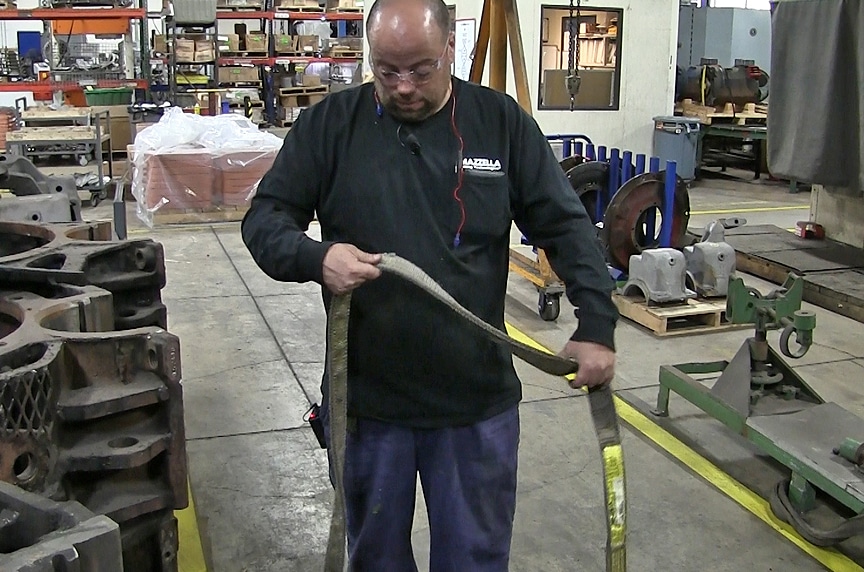
All inspections shall be performed by a designated person with any deficiencies further examined by a qualified person to identify hazards and determine what additional steps need to be taken to address the hazard.
There are two industry standards that exist to provide the end-user with guidelines to inspect synthetic web slings and criteria that warrants removal from service: OSHA 1910.184 and ASME B30.9.
Initial Inspection (Prior to Initial Use)
Best practice is to inspect synthetic web slings upon receiving them from the manufacturer. Double-check the sling tag to make sure it’s what you ordered and that the rated capacity meets all of your project specifications and lifting requirements.
Frequent (Daily or Prior to Use)
Designate a Competent Person to inspect synthetic web slings daily—a visual inspection of slings and all fastenings and attachments for damage, defects, or deformities. The inspector should also make sure that the web sling that was selected meets the specific job requirements it’s being used for.
However, users can’t rely on a once-a-day inspection if the web sling is used multiple times throughout the day. Shock loads, severe angles, edges, and excessive heat can quickly cause damage to the webbing material, so best practice is to visually inspect synthetic web slings before any shift change or changes in lifting application.
Periodic Inspection
A periodic inspection is performed by either a professional service provider, or by a Qualified Person every 12 months (at a minimum) and monthly to quarterly in more severe service conditions. The following are all determining factors in scheduling the frequency of a periodic inspection:
- Frequency of use
- Severity of service conditions
- Nature of the lifts being performed
- Experience gained on the service life of web slings used in similar applications
ASME provides these additional periodic inspection guidelines based on the service of the synthetic web sling:
- Normal Service – Yearly
- Severe Service – Monthly to Quarterly
- Special Service – As recommended by a Qualified Person
Depending on the severity of the operating environment and frequency of use, your business may decide to inspect synthetic web slings more often than the minimum yearly requirement.
Periodic inspections are required to be documented per ASME B30.9 and records retained. The employer is required to maintain a record of the most recent thorough inspection—however, individual records for each sling that was inspected are not required. Failure to maintain and retain inspection records is one of the most common issues we see that can prevent a company from reaching full OSHA compliance.
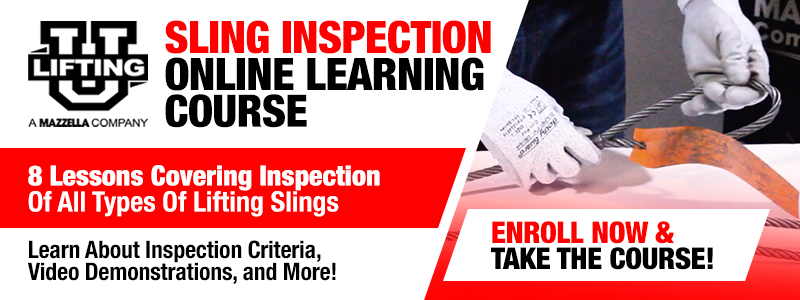
What’s Required on a Web Sling Identification Tag?
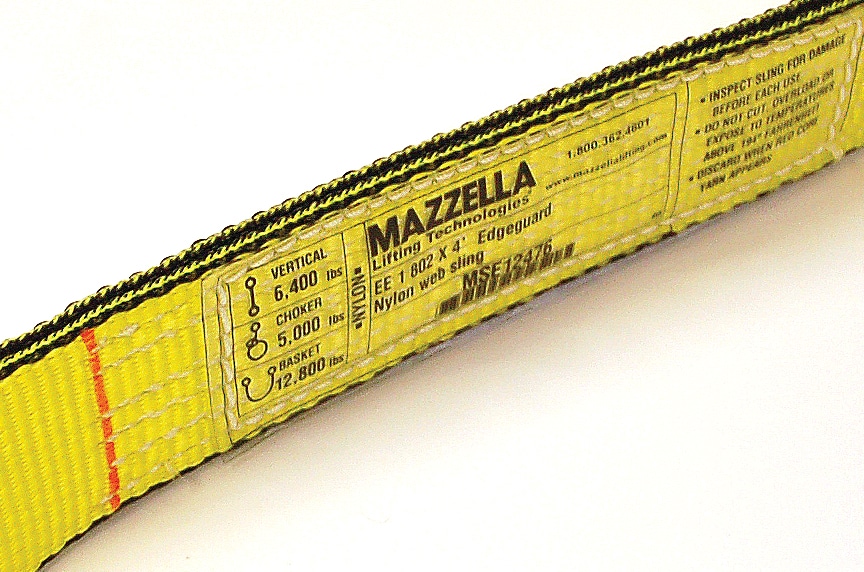
Per ASME B30.9, each synthetic web sling shall be marked by the manufacturer to include:
- Name or trademark of the manufacturer, or if repaired, the entity performing the repair
- Manufacturer’s code or stock number
- Rated load for at least one hitch type and the angle at which it is based
- Type of synthetic web material
- Number of legs, if more than one
It is the responsibility of the user to maintain the sling identification—ensuring the tag or identification is still in place and is still legible during the life of the sling. If the identification tag is missing or illegible, it is the responsibility of the inspector to remove the sling from service.
At Mazzella Companies, all of our web slings are sent out the door with our duraKlear™ identification tags. These tags have printing on the inside of the clear durable tag to protect the lettering and can easily be wiped clean. The duraKlear™ tag offers the following benefits:
- Lettering remains legible for life of the sling
- Resistant to abrasion
- Dirt, oil, and grease can easily be wiped off
- Easily inspect the webbing material under the tag
- Tag comes with UV inhibitors
Basic Inspection Criteria for Synthetic Web Slings
The goal of a web sling inspection is to evaluate remaining strength in a sling which has been used previously to determine if it is suitable for continued use. When you inspect synthetic web slings, daily visual inspections are intended to detect serious damage or deterioration which would weaken the strength and integrity of the sling.
While a web sling has a higher resistance to mildew, rot, some chemicals, and abrasion—they can still be damaged to the point where they need to be removed from service. This inspection is usually performed by the person using the sling in a day-to-day job. If during any point of the inspection the following is observed, the web sling should be removed from service and be discarded:
- Missing or illegible sling identification
- Acid or caustic burns
- Melting or charring of any part of the sling
- Holes, tears, cuts, or snags
- Broken or worn stitching in load-bearing splices
- Excessive wear or abrasion
- Knots in any part of the sling
- Discoloration and brittle or stiff areas on any part of the sling, which may indicate chemical or UV damage
- Fittings that are pitted, corroded, cracked, bent, twisted, gouged, or broken
- For hooks, removal criteria as stated in ASME B30.10
- For rigging hardware, removal criteria as stated in ASME B30.26
- Other conditions, including visible damage, that cause doubt to the continued use of the sling
ASME B30.9 standards specify that a synthetic web sling shall be removed from service immediately if any of the following conditions are present:
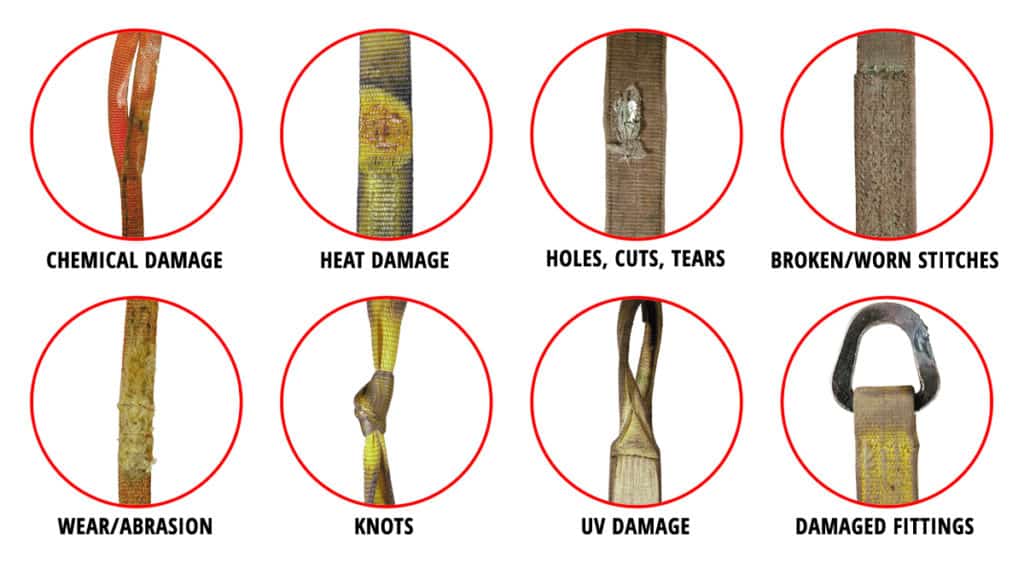
Disposal of Damaged or Failed Web Slings
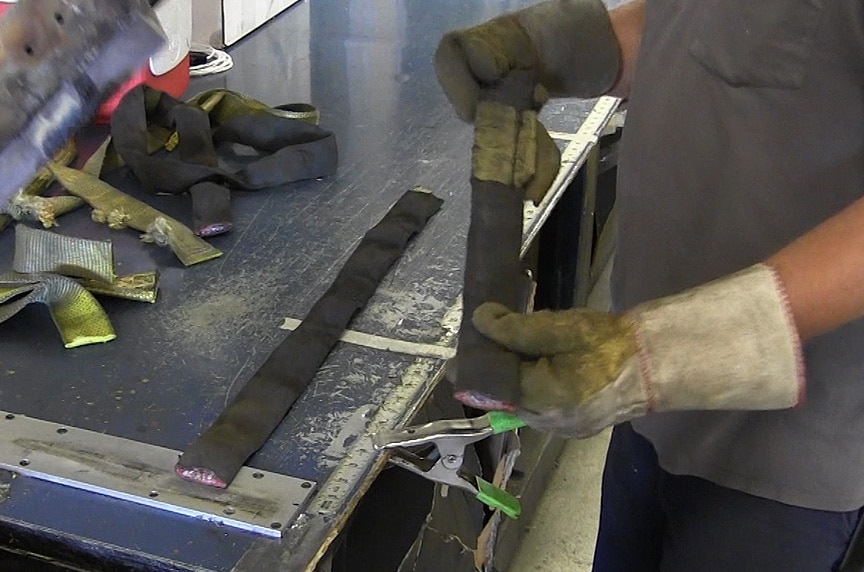
The best lifting and rigging inspection program is of no value if slings, which are worn out and have been retired, are not properly disposed of. When it is determined by the inspector that a sling is worn out or damaged beyond use, it should be tagged immediately DO NOT USE.
After a synthetic web sling inspection, if it’s determined that the sling will be removed from service, we suggest cutting the eye in most circumstances to render the sling as unusable. However, as noted previously—when the sling body is long enough, the webbing should be cut into shorter sections, and the sling should be disposed of as general waste or trash. Keep the following in mind when disposing of web slings:
- Cutting, or destroying, of the eyes prevents any further use of the sling
- As an additional step, if the sling body is long enough to allow for an eye to be reformed by other means, the sling should be cut in to shorter lengths of 3-4 feet
- Best practice is to remove, cut, or separate any tags or labels from the sling
- Place scrap into your facility’s recycling bins
Best Practices for Maintaining Synthetic Web Slings
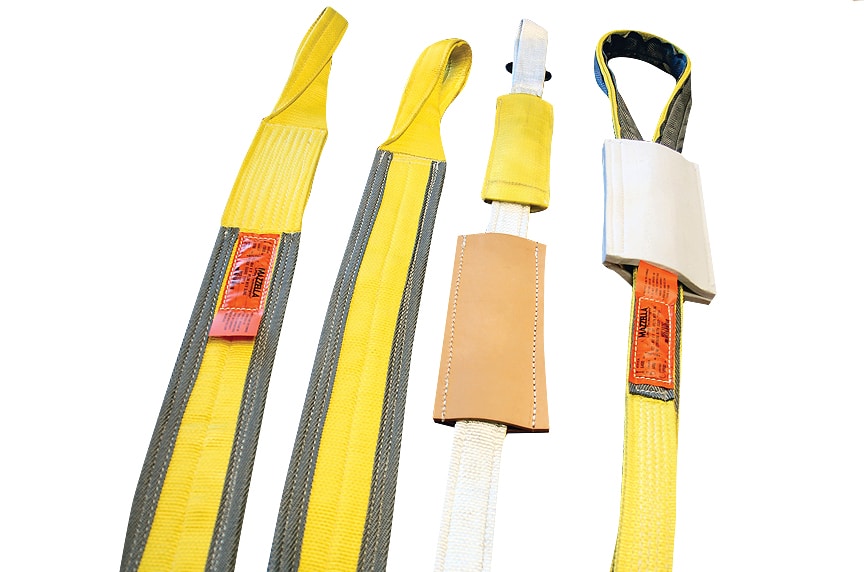
The best way to help extend the life of a web sling, and help to ensure that it stays in service, is to properly maintain it during and in-between each use. Inspections are easier to perform—and probably more thorough—when slings are easily accessible and organized, kept off of the ground, and stored in a cool and dry environment.
Hang your slings or keep them in a designated locker or rigging box where they are off of the ground and will not be subjected to mechanical damage, corrosive action, moisture, or extreme temperatures.
Temperature
Polyester and nylon web slings shall not be used in contact with an object or at temperatures in excess of 194°F (90°C) or below -40°F (-40°C).
Chemically Active Environments
The strength of synthetic web slings may be degraded by chemically active environments. This includes exposure to chemicals in the form of solids, liquids, gases, vapors, or fumes. The sling manufacturer or qualified person should be consulted before slings are used in chemically active environments.
Polyester and nylon webbing materials have different chemical resistance properties. Please refer to the chart below for guidelines on polyester or nylon web slings in specific chemically-active environments:
| Nylon | Polyester | |
| Acids | No | * |
| Alcohols | Yes | Yes |
| Aldehydes | Yes | No |
| Strong Alkalis | Yes | ** |
| Bleach Agents | No | Yes |
| Dry Cleaning Solvents | Yes | Yes |
| Ethers | Yes | No |
| Halogenated Hydrocarbons | Yes | Yes |
| Hydrocarbons | Yes | Yes |
| Ketonnes | Yes | Yes |
| Oils (Crude) | Yes | Yes |
| Oils (Lubricating) | Yes | Yes |
| Soaps & Detergents | Yes | Yes |
| Water & Sea Water | Yes | Yes |
| Weak Alkalis | Yes | Yes |
* Disintegrated by concentrated sulfuric acid
** Degraded by strong alkalis at elevated temperatures
Sunlight and Ultraviolet Light
The strength of synthetic web slings is degraded by exposure to sunlight and ultraviolet light. The sling manufacturer or a qualified person should be consulted for additional retirement or inspection requirements. Web Sling Tie Down Association’s WSTDA-UV-Sling can be consulted for additional degradation information.
Edge and Cut Protection
Synthetic lifting slings are most susceptible to cuts, rips, abrasion, and tears. Corner protectors, wear pads, or edge guards should be used to protect nylon and polyester web slings against abrasion and cuts when lifting materials with edges. Edge protection and cut protection should be used on all edges and corners—even the ones that aren’t load-bearing surfaces.
Additional material, stitching, finishing, wear pads, or coatings can also be added to synthetic web slings during the manufacturing process to help improve the durability of the sling.
Keep Your Slings Clean
Continual exposure to dust, dirt, and moisture can degrade the materials over time and shorten the life expectancy of the product. Wipe grease or oil off of your slings and try to keep them clean of dirt, or other particulates which can break down the webbing material over time.
However, web slings and other synthetic slings should never be cleaned in a solvent tank used to degrease other equipment or machined parts. The chemicals used in a solvent solution can degrade the nylon or polyester fibers over time, which will affect the integrity of that lifting sling.
Wrapping it Up
Regularly inspect synthetic web slings for damage or irregularities, prior to each use, is the best way to help keep everybody on the job site safe. Also, providing rigging training for your workers will provide them with rigging best practices and also help them to identify and take action on any damage or defects that meet ASME B30.9 removal from service criteria.
Share this article with your team and put a plan together to assess your lifting and rigging equipment and procedures. Education and transparency are key factors in any safe lifting and rigging environment. Your willingness to improve your processes confirms your commitment to job site safety and proves it’s a top priority within your company or department.
At Mazzella, we offer a variety of services including site assessments, rigging and crane operator training, rigging inspection services, sling repairs, overhead crane inspections, and so much more. Our Rigging Inspection Services group is its own dedicated business unit with a team of inspectors that are certified through Industrial Training International to meet OSHA 1910.184 and ASME B30.9 requirements for sling inspection.
If you need help getting any part of your lifting and rigging program on track towards compliance, please don’t hesitate to contact us today.
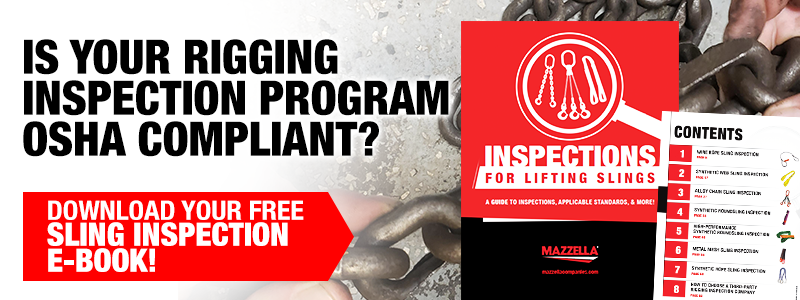

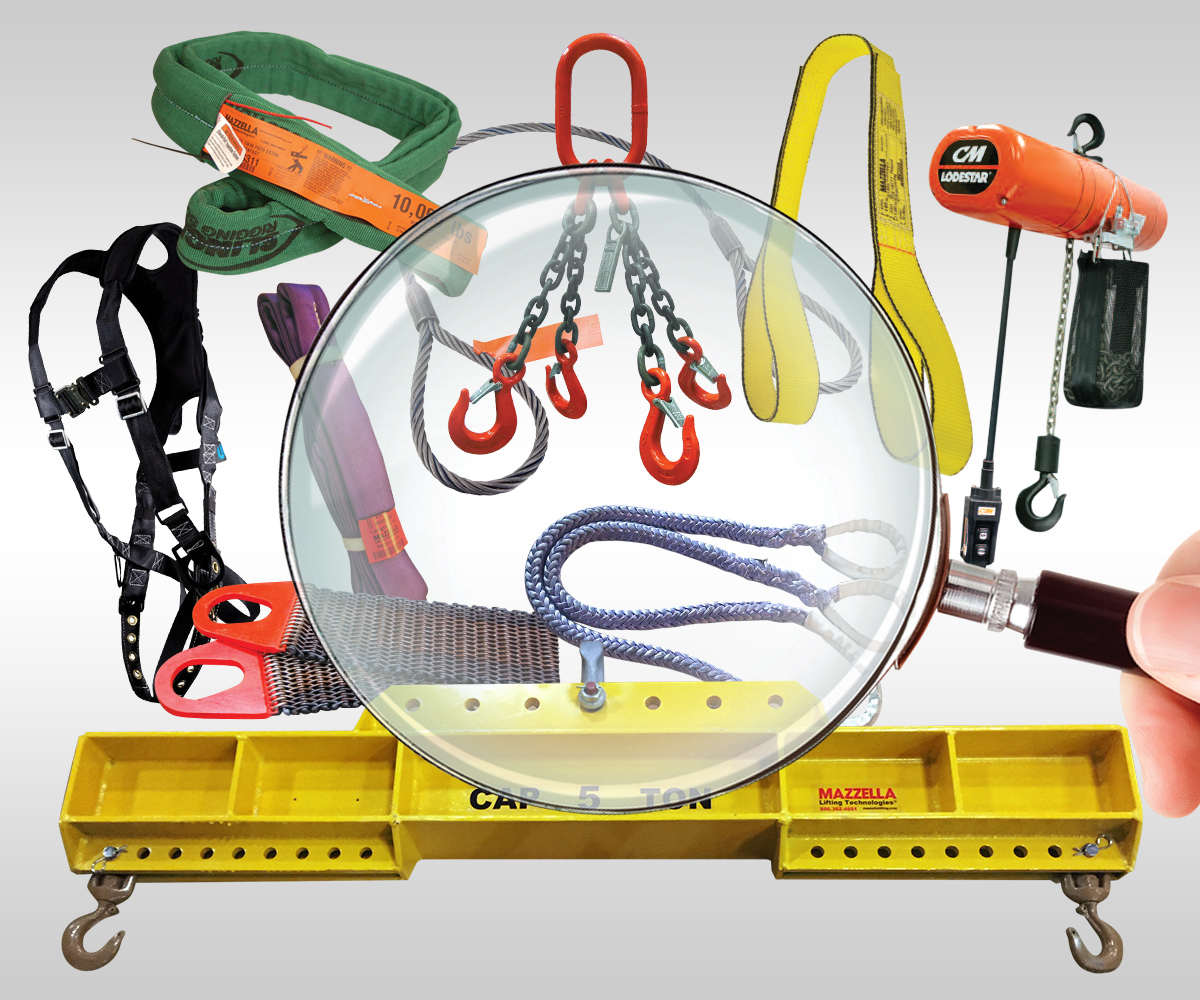
Rigging Inspection Services
OSHA 1910.184, ASME B30.9, B30.20, B30.26, & ANSI Z359 require periodic, documented inspections on slings, rigging hardware, lifting devices, and fall protection every 12 months, at minimum, and monthly to quarterly in more severe service conditions.
Call us at 800.362.4601 or click here if you need inspections for slings, rigging hardware, lifting devices, or fall protection!
Copyright 2018. Mazzella Companies.
